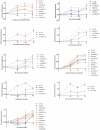Identification of agonists for a group of human odorant receptors
- PMID: 25784876
- PMCID: PMC4347425
- DOI: 10.3389/fphar.2015.00035
Identification of agonists for a group of human odorant receptors
Abstract
Olfaction plays a critical role in several aspects of the human life. Odorants are detected by hundreds of odorant receptors (ORs) which belong to the superfamily of G protein-coupled receptors. These receptors are expressed in the olfactory sensory neurons of the nose. The information provided by the activation of different combinations of ORs in the nose is transmitted to the brain, leading to odorant perception and emotional and behavioral responses. There are ~400 intact human ORs, and to date only a small percentage of these receptors (~10%) have known agonists. The determination of the specificity of the human ORs will contribute to a better understanding of how odorants are discriminated by the olfactory system. In this work, we aimed to identify human specific ORs, that is, ORs that are present in humans but absent from other species, and their corresponding agonists. To do this, we first selected 22 OR gene sequences from the human genome with no counterparts in the mouse, rat or dog genomes. Then we used a heterologous expression system to screen a subset of these human ORs against a panel of odorants of biological relevance, including foodborne aroma volatiles. We found that different types of odorants are able to activate some of these previously uncharacterized human ORs.
Keywords: GPCRs; functional screening; heterologous expression; human odorant receptor; human olfactory receptor; odorant perception; odorants; orphan receptors.
Figures




Similar articles
-
Olfactory receptor function.Handb Clin Neurol. 2019;164:67-78. doi: 10.1016/B978-0-444-63855-7.00005-8. Handb Clin Neurol. 2019. PMID: 31604564 Review.
-
In vivo identification of eugenol-responsive and muscone-responsive mouse odorant receptors.J Neurosci. 2014 Nov 19;34(47):15669-78. doi: 10.1523/JNEUROSCI.3625-14.2014. J Neurosci. 2014. PMID: 25411495 Free PMC article.
-
Modulation of the combinatorial code of odorant receptor response patterns in odorant mixtures.Mol Cell Neurosci. 2020 Apr;104:103469. doi: 10.1016/j.mcn.2020.103469. Epub 2020 Feb 12. Mol Cell Neurosci. 2020. PMID: 32061665 Free PMC article.
-
Deorphanization and characterization of human olfactory receptors in heterologous cells.Chem Biodivers. 2014 Nov;11(11):1764-81. doi: 10.1002/cbdv.201400083. Chem Biodivers. 2014. PMID: 25408322
-
Combining In Vivo and In Vitro Approaches To Identify Human Odorant Receptors Responsive to Food Odorants.J Agric Food Chem. 2018 Mar 14;66(10):2214-2218. doi: 10.1021/acs.jafc.6b04998. Epub 2017 Jan 17. J Agric Food Chem. 2018. PMID: 28054485 Review.
Cited by
-
Discovery of (-)-epigallocatechin gallate, a novel olfactory receptor 2AT4 agonist that regulates proliferation and apoptosis in leukemia cells.Heliyon. 2024 May 5;10(10):e30298. doi: 10.1016/j.heliyon.2024.e30298. eCollection 2024 May 30. Heliyon. 2024. PMID: 38778941 Free PMC article.
-
Qualitative and Quantitative Sex-Related Differences in the Perception of Single Molecules from Coffee Headspace.Foods. 2024 Oct 11;13(20):3239. doi: 10.3390/foods13203239. Foods. 2024. PMID: 39456301 Free PMC article.
-
Predicting Human Olfactory Perception from Activities of Odorant Receptors.iScience. 2020 Aug 21;23(8):101361. doi: 10.1016/j.isci.2020.101361. Epub 2020 Jul 12. iScience. 2020. PMID: 32731170 Free PMC article.
-
How does your kidney smell? Emerging roles for olfactory receptors in renal function.Pediatr Nephrol. 2016 May;31(5):715-23. doi: 10.1007/s00467-015-3181-8. Epub 2015 Aug 12. Pediatr Nephrol. 2016. PMID: 26264790 Free PMC article. Review.
-
Olfactory Receptors as an Emerging Chemical Sensing Scaffold.Biochemistry. 2023 Jan 17;62(2):187-195. doi: 10.1021/acs.biochem.2c00486. Epub 2022 Nov 1. Biochemistry. 2023. PMID: 36318941 Free PMC article. Review.
References
LinkOut - more resources
Full Text Sources
Other Literature Sources
Molecular Biology Databases

